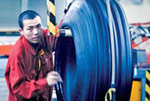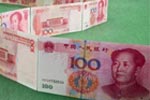Benefits of carbon control policy
Updated: 2011-09-02 17:16
By Dale Jorgenson, Mun Ho and Cao Jing (China Daily)
|
|||||||||||
China is not among the countries with carbon reduction obligations under the United Nations Framework Commission on Climate Change. However, major world powers have been pressuring China to participate more actively in controlling carbon emissions.
Recognizing this issue, the Chinese government has announced that it would reduce the carbon intensity of GDP by 40-45 percent by 2020 from the 2005 levels. If China's GDP growth on average is 8 percent a year, it will be 3.2 times the level of 2005 in 2020. And even if China achieves its carbon reduction target, its emissions will be 75-90 percent higher in 2020 compared to 2005 levels.
These figures highlight the fact that the target of carbon intensity reduction is only the first step toward the goal of stabilizing and eventually reducing emissions.
If China wishes to reduce emissions at a faster rate, it would have to consider other policy options. For example, under the European Union Emissions Trading Scheme, large emitters are required to have emission allowances to cover their carbon dioxide (CO2) emissions. Most enterprises are given an initial allocation of such allowances, but may need to purchase more to cover their emissions when output increases with time. The idea of this "cap-and-trade" scheme is to provide a price incentive to reduce CO2 emissions. Policy proposals such as the Waxman-Markey bill passed by the United States House of Representatives also incorporate "cap and trade".
Another approach would include the introduction of a carbon tax, whereby fossil fuels would be subject to a tax in proportion to their carbon content. Australia has announced a plan to introduce a carbon tax next year. A strong effort to reduce carbon emissions through a carbon tax or a "cap-and-trade" scheme will thus have wide ranging ramifications, since fossil fuel use is related, directly or indirectly, to almost every economic activity.
What are the costs and benefits to China of controlling CO2 emissions? The key is to recognize that burning fossil fuels not only release CO2, but also soot, sulfur dioxide, nitrogen oxides and other pollutants. These pollutants damage human health and the environment. Soot, sulfates and nitrates contribute to the fine particulate matter that goes deep into our lungs and leads to premature mortality, as well as chronic bronchitis and other respiratory ailments.
The aim of a Harvard University-Tsinghua University study is to account for the costs and benefits of carbon control as comprehensively as possible. This means taking into account how reducing fossil fuel use improves public health in addition to reducing CO2 emissions. To do so, environmental engineers and atmospheric scientists have estimated how reductions in the use of coal, oil and gas would reduce the emissions of soot, sulfur dioxide and other chemical particles into the atmosphere. This would improve air quality all across China.
To compare the economic costs with the health benefits more easily, we converted the reduction in premature mortality and hospital admissions into a monetary value. Economists do this by considering the valuations for risk reductions. What would people be willing to pay, say, for reducing the risk of death from an industrial accident? This is obviously a difficult and uncertain exercise, but studies in China put such a "value of statistical life" at between 0.2 and 1.4 million yuan.
As an illustrative exercise we considered a modest carbon tax of 100 yuan per ton of carbon (or about 27 yuan or $4.3 per ton of carbon dioxide). We projected how this would have changed the growth of the economy over the 2006-10 period, that is, how it would compare to a situation without such a tax but with the current policies and trends in place. The reductions in emissions of CO2 and other pollutants as a result of the carbon tax are thus in addition to the reductions under current policies.
On the cost side we find a small reduction in GDP, as little as 0.1 percent, when enterprises react to the more expensive energy by switching to low carbon inputs. We estimate that coal use would fall by 15 percent and overall energy use by 11 percent, leading to a 12 percent reduction in CO2 emissions. The improvement in air quality because of the parallel reductions in particulate matter and other pollutants would reduce premature mortality by 19,000 lives a year.
The less precisely estimated chronic mortality effect would be a much larger 100,000 lives a year. We also estimated a substantial reduction in hospital admissions for respiratory problems. Valuing these health effects conservatively would put them at 56 billion yuan, or about 0.2 percent of GDP. The carbon tax is thus an effective multi-pollutant control strategy.
In sum, the vast majority of man-made greenhouse gases currently in the atmosphere came from the developed countries, so the rich countries should make the biggest efforts to reduce emissions.
But there are good reasons for China to adopt carbon control policies. The direct contribution to reducing the risks of climate change will benefit every country in the world, but the parallel reduction in conventional pollutants like sulfur dioxide and particulate matter would substantially benefit human health and eco-systems within China. The benefits to human health alone would greatly outweigh the modest loss in China's GDP.
Dale W. Jorgenson is Samuel W. Morris University professor at Harvard University, Mun Ho is a research scholar at Resources for the Future at Harvard University, and Cao Jing is an associate professor of economics at Tsinghua University.
Related Stories
China to pilot carbon emission trading 2011-07-18 09:38
China to launch carbon emissions trading pilot project 2011-07-18 08:02
China to pilot carbon emissions trading project 2011-07-18 07:32
China to pilot carbon emissions trading 2011-07-17 20:18
- Substandard mooncakes found
- Oil spills trigger environmental concerns
- China probes into steel tubes from EU, Japan
- PBOC may launch RMB QFII trials soon
- China to further facilitate investment
- Apple closer to offering 3G iPad 2 in mainland
- Call for stronger trade ties
- Provinces to face winter power shortages













